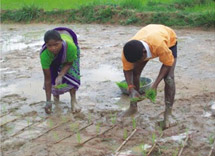Dharohar Samiti- Promoting Traditional Rice

Chhattisgarh, a centrally located State of India is popularly known as 'Rice Bowl' of India; not only because of the high production of rice in the State but also because of over 20,000 rice varieties recorded in the region. It boasts of its traditional heritage of farming communities through selection and adaptation to a variety of soil, water and micro-ecosystems conditions including predators.
These known varieties are vanishing slowly because of the popular High-yielding varieties taking over the market. Synthetic fertilizers and pesticide-based agriculture is alluring the farmers to give up on traditional varieties of farming for better yield. At the same time spreading a common misconception about farming of traditional varieties as low yielding. There has also been tremendous loss of traditional knowledge associated with traditional agro-ecosystems and production practices.

Dharohar Samiti, a farmer's organization has taken up the cause and working with farmers in 10 villages of Kondagaon Tehsil in Bastar district of Chhattisgarh for conservation of traditional varieties from last 15 years. They are focusing mainly to promote Bio-diversity conservation and secure livelihood and nutrition to farmers. Dharohar Samiti has been supported by UNDP GEF Small Grants Program (SGP) in their mission of conserving over 260 traditional varieties of rice along with other minor millets such as raagi, kodo and kutki.
Dharohar Samiti, with help of SGP project has introduced the System of Rice Intensification (SRI) based on successful trials and studies. System of Rice Intensification is an organic farming technique that requires only about 1/10th seed and less water compared to the traditional method of farm flooding and larger spacing between rows. Attention to soil health balance helps in profuse production tillers and increase in yield.

The yield of traditional varieties like Basabhog and Asamchudi reaches up to 7 to 8 tonnes per hectare through SRI, which is as good as any High Yielding Variety in the market. This SRI technique has further adaptation for profitable cultivation of Raagi.
Dharohar's work has demonstrated effective ways of agro-biodiversity conservation along with yield enhancement using organic methods that are critical for the ecological integrity of this agro-climatic region of Bastar. Dharohar sows their rice varieties every year on a 2.5 acre farm in Golawand village and keeps the genetic evolution process on.

- Dharohar provides a platform for farmers to discuss issues related to degradation of environment and loss of traditional varieties developed over centuries.
- Through village level assemblies of tribal farmers, the techniques of preparation and use of herbal pesticides were tried out and integrated into traditional farming practices.
- Dharohar also tries to establish and strengthen the linkages with govt. departments and other resource organizations.
- Dharohar is also involved in distributing the seeds to the farmers in Kondagaon and Narayanpur tahsils, promoting exchange of seeds and herbal pesticide development among framers and wider sharing of information with tribal communities through village-level meetings and Madai-Melas (fairs).
- The community has started bio-diversity documentation through developing people's bio-diversity registers in 5 villages. With focus on non-cultivated food resources, it has documented 47 sources including pot-herb species, tubers, flowers and mushrooms. As many as 8 types of mushrooms were recorded from the area. Efforts are on to document traditional knowledge with appropriate protection measures.
Thirty nine new rice varieties from remote villages of Bastar have been identified and added to existing collection in last two years. Taking technical support from rice scientist Jacob Nellithanam, Dharohar has started scientific characterization of 49 varieties so that they are recognized legally by becoming part of National Bureau of Plant Genetic Resource.
Source: http://www.craftandartisans.com/clay-terracotta-of-chhattisgarh.html


